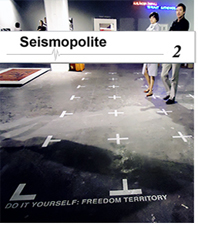December 10, 2011
Editorial
The world is changing: the corruption and hypocrisy of our current market economy and its buffer shield and facilitator; the nation state – whose legitimacy is falling apart along with the evidence of its disinterest in putting the lives of its peoples first, its privatization of gains and socialization of losses; its unrelenting enforcement of barriers towards countries in the southern hemisphere, continuous recirculation of identities and rights of immigrants whose cultures we are supposed to fear every day, much more than global market exploitation anyway; a fear whose only possible remedy seems to be the shopping mall – is becoming increasingly clear to increasing parts of the world’s population. At the same time, while revealing the brutality behind the facade of a liberal democracy by falling victim to it, the determination of the Occupy Wall Street Movement to win back democratic rights and public spaces, to horizontally organized solidarity towards a common goal that includes all mankind, and to peaceful protest against a corrupt system – gives us one of the most promising reasons for optimism since decades.
In this political situation, art also has a potential function. To experiment with this function through different strategies is also the focus in the exhibition Details at Bergen Kunsthall, of which we bring a review, and which deals with the theme of everyday repositories of fascism and sheds a critical light on forms of hidden repression and discipline under neoliberalism in different geographical contexts across Europe and in Scandinavia and the US.
This issue brings texts about art and politics from a number of localities worldwide. For example, June Yap comments on a theatre play, Fear of Writing, which deals with the dilemmas artists go through due to censorship, and draws attention to the societal role art can play in reaching understanding and creating a common future in Singapore. At the same time Yap poses the question of what the "new normal", which one has heard about from the political level for a while, will mean after this year's presidential election and the parliamentary elections which were the first real elections in a country which has been ruled by one party since it was founded.
In an interview, Övgü Gökçe describes the many activities and the daily challenges of the Diyarbakır Art Center in the city of Diyarbakır in Southeast Turkey, which has been fraught with armed conflict between Turkish forces and the Kurdish separatist guerilla for 3 decades. Diyarbakır Arts Center (DSM) is the Diyarbakır branch of Anadolu Kültür based in Istanbul, an organization whose aim is to discover and help develop cultural and artistic potentials in cities all over Anatolia, and which works to build bridges between diverse cities in Turkey, and to cities and art scenes internationally.
In an essay May Adadol Ingawanij and David Teh give us local, and until now very little known perspectives on the body of work of last year's Palme d’Or-winning Apichatpong Weerasethakul. The writers shed a light on the many tensions that are channelled, yet somehow balanced in the films of this director who notoriously defies tenable characterizations.
Chris Mansour reviews Tania Bruguera’s Immigrant Movement International, an art project and community center for immigrants in Queens, New York, and discusses the implications of her concept of Arte Útil (“useful art”) which she opposes to an idea of aesthetic autonomy. Mansour argues that Bruguera, despite good intentions, in this way exposes her practice to a number of unnecessary obstacles.
The second issue also includes reviews of the 12th Istanbul Biennial whose theme is art and politics, and which combines artworks that are both formally innovative and politically outspoken. The biennial uses the exhibition architecture to deconstruct the exhibition space, and reclaims it as a pure function of the visitors' bodily and intellectual possibilities of navigation.









